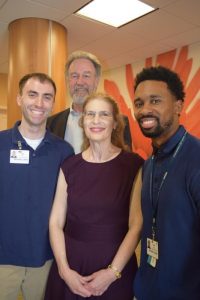National Cardiac Rehabilitation Week is February 14-20, and it highlights the major role that cardiac rehabilitation plays in reducing the effects of heart disease. Cardiac rehabilitation can’t change what happened in the past. But it can change the future following a heart attack, heart failure or heart surgery. 1
A life-changing experience
At the Post-Acute Care Center at Hebrew Home of Greater Washington, the emphasis is to support you through your transition plan. CESLC has in-house physicians who routinely coordinate with outpatient cardiologists to deliver the best possible care for cardiac rehabilitation patients. This coordination is bolstered and supported by a group of therapists, nurses, social workers and even family and friends.

Meet Rita Helgeson and her support team
Two years ago, while planning her daughter’s wedding, Rita experienced a life-threatening cardiac event that required surgery and prolonged hospitalization. Eventually transferred to the Post-Acute Care Center, Rita says that she was “white like a ghost, totally debilitated, and barely able to get out of bed.” She attributes recovery to the skills of occupational therapist Scott Fernandez and physical therapist Max Collins.
“They were tops in my opinion,” she says and praises their sensitivity and persistent encouragement at every single stage of a demanding rehabilitation program. She explains that Collins coached her through while Fernandez helped her regain strength and balance to resume daily activities. Cardiac rehabilitation places a focus on physical training, but also education around heart-healthy living such as diet and weight, as well as strategies to identify and tackle sources of stress.1
For Paul Myer, who experienced multiple neural fusion surgeries followed by sudden paralysis and a heart attack, the Post-Acute Care Center was a blessing. Myer “can’t speak highly enough about the post-acute staff,” adding that “the whole department is top notch”. Hear Paul Meyer talk about his care at the Post-Acute Care Center.
Cardiac rehabilitation: An ounce of secondary prevention
Millions of Americans are eligible for cardiac rehabilitation, but less than half of people referred for the programs actually enroll. Even fewer take advantage of the benefits that programs provide,2,3 included improved overall life quality, reduced risk of future illness, and even a longer life expectancy.4 Think of it as secondary prevention against a range of health conditions and lifestyle habits that contribute to heart disease, or extra insurance against the risk of a future heart event.
Learn more about the care that you can receive at Post-Acute Center at Hebrew Home of Greater Washington by calling 301-770-8476.
- What is cardiac rehabilitation? American Heart Association. July 2016. https://www.heart.org/en/health-topics/cardiac-rehab/what-is-cardiac-rehabilitation. Accessed 1/30/2019.
- Thomas RJ, Balady G, Banka G, Beckie TM, Chiu J, Gokak S, Ho PM, Keteyian SJ, King M, Lui K, Pack Q, Sanderson BK, Wang TY. 2018 ACC/AHA Clinical Performance and Quality Measures for Cardiac Rehabilitation: A Report of the American College of Cardiology/American Heart Association Task Force on Performance Measures. J Am Coll Cardiol. 2018 Apr 24;71(16):1814-1837. doi: 10.1016/j.jacc.2018.01.004. Epub 2018 Mar 29.
- Menezes AR, Lavie CJ, Milani RV, Forman DE, King M, Williams MA. Cardiac rehabilitation in the United States. Prog Cardiovasc Dis. 2014. Mar-Apr;56(5):522-9. doi: 10.1016/j.pcad.2013.09.018. Epub 2013 Oct 25. Review.
- Pesah E, Supervia M, Turk-Adawi K, Grace SL. A Review of Cardiac Rehabilitation Delivery Around the World. Prog Cardiovasc Dis. 2017 Sep – Oct;60(2):267-280. doi: 10.1016/j.pcad.2017.08.007. Epub 2017 Aug 24. Review.
